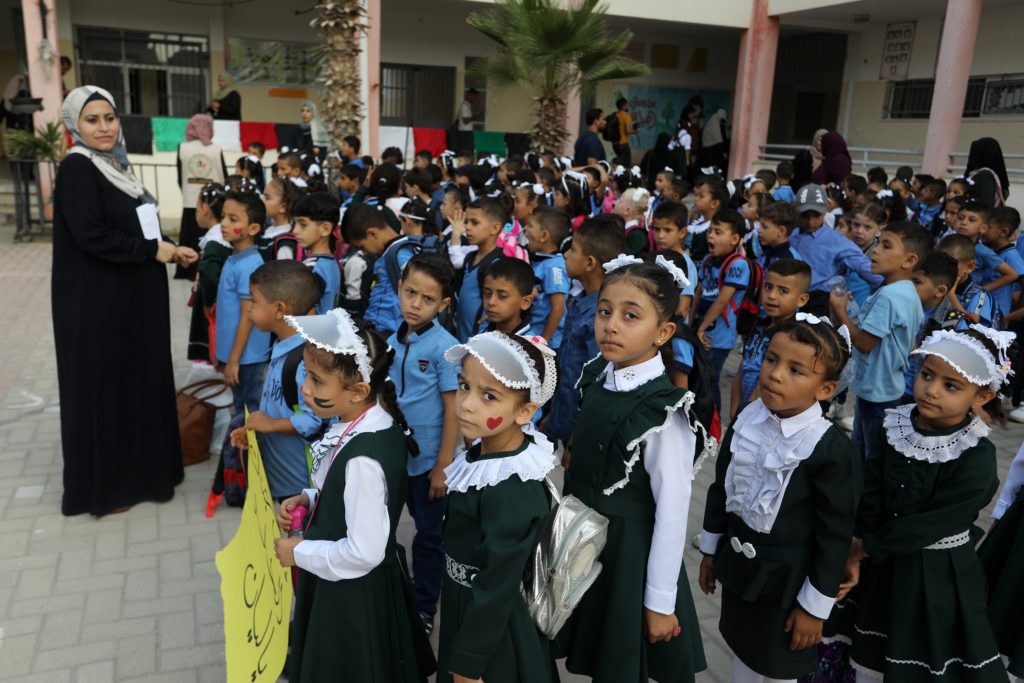FRESH AIR
UNRWA and the Miseducation of the Palestinian people
February 12, 2024 | Tammy Reznik

Attending my local primary school in the 1980s in Australia was an interesting time. I recall fondly my year four teacher imparting his love of geography and Beatles music to us his students. The day would begin with a rendition of ‘She’s Leaving Home’ or ‘Eleanor Rigby’ and end with a pop quiz of capitals or flags of the world. He was a little quirky, but to this day I still remember my capital cities, while my primary school buddy attributes his enduring passion for music to this class. Teachers can leave a definitive imprint on our lives, and education, even early education, has been proven to profoundly influence our future thinking.
With this in mind, imagine the potential damage that could ensue from a curriculum based on hatred, division and the literal elimination of “enemies”; one where the songs being taught are not melodies of love but hymns of death, where the maps being used are carefully crafted to erase and delegitimise an entire nation of people. Sadly, we don’t need to imagine this – there is ample evidence that this very process is happening in the schools run by the United Nations Relief and Works Agency (UNRWA) in Gaza and the West Bank.
Since the horrific Hamas terror attacks of October 7 inside Israel, and especially in recent weeks, the problems of UNRWA have been very much in the headlines – especially revelations at least 12 UNRWA employees took part in those attacks, and Israeli allegations that as many as 10% of all UNRWA employees are affiliated with terrorist groups. Then came a startling discovery by the IDF in early February of a subterranean Hamas data and computer server system deep under the UNRWA head office in Northern Gaza, the entrance to which was purposely built under an UNRWA school. This centre was so sophisticated that it must been there for many years, and thus it is impossible to imagine how UNRWA staff were unaware of its presence. They must have been aware of its construction, and furthermore, the electricity for the Hamas facility was taken directly from the UNRWA building.
But UNRWA’s responsibility for terrorism through the education system it runs – propped up by billions of dollars in mostly Western aid – deserves almost as significant scrutiny as its direct terrorist links.
UNRWA was established in 1949 to serve Palestinian refugees displaced during Israel’s War of Independence. Today, UNRWA continues to operate in the Gaza Strip, West Bank, Lebanon, Syria, and Jordan. Established with a narrow focus on the Palestinian refugee population and only that population, UNRWA by its own admission “does not have a mandate to resettle Palestine refugees and has no authority to seek lasting durable solutions for refugees.” This is one of many ways it contrasts with all other UN agencies, and especially the UN main agency for refugees, the UN High Commissioner for Refugees (UNHCR). The latter, which serves all other refugee populations in the world who are not Palestinian, has to meet the needs of some 100 million people with a modest staff of 18,000 people. To service 5.9 million Palestinians defined as refugees using the unique definition the agency utilitises, UNRWA employs 30,000 staff – 99% of whom are themselves Palestinian.
During the current Israeli-Hamas conflict, UNRWA is being portrayed as the only agency that can provide much-needed humanitarian aid to desperate Gazans displaced by war, but in normal times, UNRWA is not really a humanitarian aid agency at all. Overwhelmingly, what it does is provide free education and healthcare to Palestinians it defines as refugees.
The most significant sector of UNRWA’s operations is education. UNRWA oversees one of the largest school systems in the Middle East, and importantly more than half of UNRWA’s budget is in education, and it is where the majority of its staff are employed. There are 183 UNRWA-run schools across the Gaza Strip, educating more than 286,000 students, according to UNRWA’s data (plus many other schools in the West Bank, and in other Middle Eastern countries).
The most recent set of incriminatory allegations against UNRWA, emerging from a six-page intelligence dossier, revealed that a number of those UNRWA employees accused of actively participating in October 7 massacre in southern Israel were from the education sector. The initial evidence is that of the at least 12 employees who participated in the October 7 attacks, one was a school counsellor who coordinated an abduction with his son, while others supplied ammunition to the terrorists, and another was close enough to a victim to take a photograph.
Hate Education
The entire UNRWA education project has actually been under scrutiny for some years and rightly so, with a number of major investigations into its education programs and the endemic level of indoctrination in its schools.
A damning study published after the October 7 massacre by IMPACT-se (a global NGO that researches school textbooks, teachers’ guides and curricula) revealed not only the hate-filled educational materials deployed in UNRWA schools – which are often produced by the Palestinian Authority – but also the direct participation of UNRWA staff in producing material promoting incitement to violence and hatred. The new report analysed a sample of 82 UNRWA teachers and other staff affiliated with more than 30 UNRWA schools who had overseen the drafting, supervising, approving, printing, and distributing of hateful content to students.
- An UNRWA-created Arabic reading comprehension exercise for 9th graders at UNRWA’s Al Maghazi Middle School for Boys B (Gaza), which celebrated a Palestinian firebombing attack on a Jewish bus as a “barbecue party”.
- A grade 5 Arabic language lesson that directly praised Palestinian terrorist leaders, such as Izz al-Din al-Qassam and Dalal Mughrabi, as positive role models.
- A grade 5 Islamic Education textbook that contains content inciting violence and Jihad against Israel and others. (Islamic Education, Grade 5, Vol. 1, 2023, p. 38)
In 2021, UNRWA also developed books as part of a new curriculum specifically to be used during the COVID pandemic. These texts were once again replete with lessons that sought to incite violence and hatred, and glorify terrorism. UN Watch revealed one lesson in which children in the third grade were taught Arabic numerals with a specific exercise in a maths textbook requiring them to choose from a list the correct number of martyrs in the First Intifada. There were texts that told students to “defend the motherland with blood”. And in geography lessons, Israel was omitted from maps in the UNRWA-produced materials, the entire territory being labelled as a “Palestine” with no demarcation lines. When it is mentioned at all, Israel is referred to mostly as “The Enemy” or the “Zionist Occupation”. This review prompted UN representative Stephane Dujarric to state that “An urgent and comprehensive independent review of UNRWA will be conducted.” So, what was the outcome of this review? No one seems to know.
In April 2020, after years of observing UNRWA schools, the European Parliament became the first legislature to adopt a resolution expressing concern over funding for UNRWA. The resolution called for a halt to textbooks and materials that were seen to promote hate and incite violence, and questioned “the effectiveness of UNRWA’s mechanisms of adherence to UN values” in its educational materials. The text of the 2020 resolution called for EU funding for salaries paid to teachers and public servants in the education sector to “be made conditional on educational material and course content complying with UNESCO standards of peace, tolerance, coexistence, and non-violence.” It also called for UNRWA to publish its materials on an open-source platform to encourage greater transparency.
None of this happened, and every year since then, the European Parliament has again passed a resolution condemning the textbooks used by UNRWA, and demanding that “all anti-Semitic references are deleted, and examples that incite hatred and violence are removed.”
Meanwhile, the UNRWA educational landscape – that is the physical schools themselves – have for years been employed as Hamas weapons storage units and command centres. There have been repeated examples of Hamas storing rockets inside UNRWA schools or using school grounds as launchpads for attacks. According to an interview the Israeli brigade commander of Unit 646 serving in Gaza gave to an Israeli news outlet, during the current conflict, his forces had not entered a single UNRWA school that didn’t have weapons in it. In fact, he said, his units see UNRWA schools as more hostile than homes, because the schools are likely to have booby traps and weapons.
UNRWA Education Staff activities outside the Classroom
An investigation released by UN Watch on Jan. 10 revealed a Telegram group of 3,000 UNRWA teachers in Gaza filled with posts of praise and encouragement for the October 7 massacre, just minutes after it began. Some employees on this chat even went as far as sharing photos of dead or captured Israelis, whilst Hamas murderers and rapists were described as “heroes”, and their “education” lauded. There were reportedly thousands of such posts. Aside from highlighting the inappropriateness of such behaviour by any UN employee, this study also reveals the total enmeshment of the schools and the terrorist ideology. Inversely, UNRWA employees have been reprimanded in the past for using terms that describe Israel as having military might, as this is seen as tacit support for Israel.
Earlier, an IMPACT-se study had looked into the social media activity of UNRWA staff, and documented that at least 14 teachers and staff at UNRWA schools had made statements on their social media accounts publicly celebrating the October 7 massacre. One UNRWA teacher in the school system in Gaza, Sarah Alderawy, posted a video clip on the day of the massacre showing Hamas terrorists roaming the Israeli streets with rifles while shooting at Israeli cars and rocket attacks. Another UNRWA teacher, Bilal Ahmed, posted a Quranic verse on the morning of October 7, when the Hamas attacks began, implying that God’s punishment to Israel had arrived: “Indeed, their meeting of their fates is [for] the morning. Is not the morning near?”
Today, UNRWA claims that it is the only organisation that can currently provide essential aid to more than a million Palestinians in need. Yet it has no board of directors or other real source of accountability except for the willingness of donors to withhold funds. UNRWA also does not recognise Hamas as a terror organisation, and there are reports that much of the aid currently going into Gaza is being diverted into Hamas’ hands. Israeli intelligence estimates that Hamas is ultimately getting up to 60% of all aid entering Gaza while the Guardian newspaper has reported that “aid agencies trying to distribute food, fuel and other essentials to the displaced in southern Gaza continue to deal with Hamas-appointed officials. Hamas still provides police escorts for convoys.”
UNRWA schools are proving to be both ideologically and physically unsafe. The prevalence and reach of Hamas, and its death cult ideology, have managed to spread so adeptly in large part because of UNRWA, not despite it. The war in Gaza has uncovered damning evidence of UNRWA’s complicity in the intentional and systematic inculcation of hate against Jews as part of the education system, but worse still a level of indoctrination with the demonic terrorist-martyrdom Hamas ideology as an integral part of its curriculum. UNRWA education may well have poisoned the minds of an entire generation, stoking the current bloodshed and making peaceful coexistence all but impossible in the short and medium term.
Tags: Gaza, Hamas, Israel, UNRWA, United Nations























